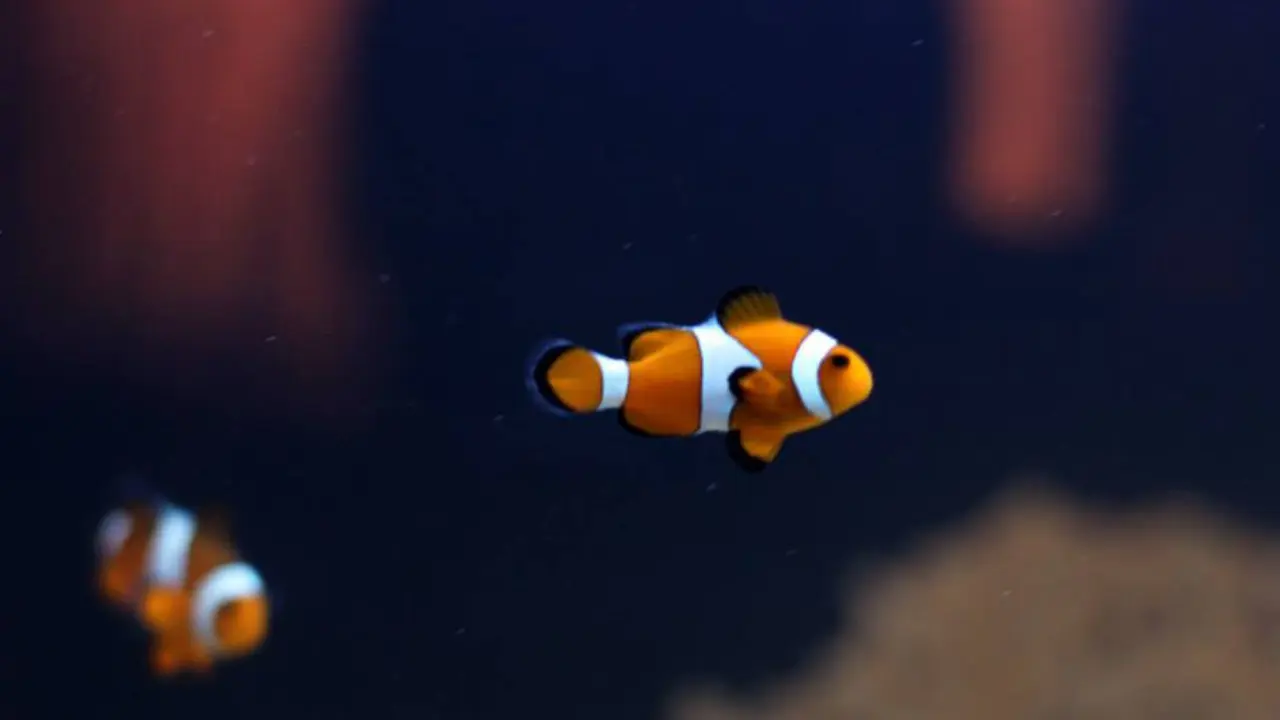How To Tell If A Clownfish Is Pregnant?

The best way to tell if a clownfish is pregnant is to observe its behavior and look for signs such as aggressive territorial behavior, changes in the abdomen, clearing substrate before spawning, protrusion, laziness or inactivity of clownfish, nesting, etc.
6 Clownfish Pregnancy Signs?
Knowing the signs of a pregnant clownfish can assist you in providing the best care for your fish and ensuring their health and safety. Let’s discuss elaborately 6 early signs that help you decide whether your clownfish is pregnant.
Aggressive Territorial Behavior
The first thing to look for when determining if your clownfish is pregnant is a change in its behavior. Pregnant clownfish may become more aggressive as they try to establish a territory for their offspring. They may also become more reclusive and spend more time hiding in their home.
Related Reading:How To Reduce Clownfish Aggression?
Changes in Abdomen
In addition to behavior changes, you may also be able to tell if your clownfish is pregnant by looking at its physical appearance. When a female clownfish becomes pregnant, it grows larger. In Particular, you will see the female performed gonadal maturation with a character, i.e., a swollen abdomen and extended oviducts, and appeared colored milky red before spawning.
Protrusion
During pregnancy, you will see something large tube-like protruding from the body of both the male and female clownfish. These are sex organs. The process of sperm fertilization requires these sex organs. If you see these protrusions, your clownfish is most likely preparing to breed.
Clearing Substrate Before Spawning
In preparation for spawning, the broodstock pairs work together to clean the substrate or wall area of the shelter actively. Clownfish usually prefer smooth and hard surfaces for laying eggs. Cleaning was conducted by the mouth and fin for 4 to 5 h with the purpose of obtaining a rough substrate surface for egg attachment.
The shelter area attachment of the eggs is oval or round in shape and can be located on the inner or outer wall of the shelter. Typically, pairs start clearing substrate to attach eggs two days before spawning.
Laziness Or Inactivity Of Clownfish
The general level of activity and behavior of your clownfish can signal a variety of things. One of the most common reasons a clownfish becomes inactive and lazy is that it may be pregnant.
If your clownfish isn’t swimming around as much as it used to and spends a lot of time lying on the bottom of the tank, it could be pregnant. Pregnant clownfish often become less active and may even swim around one place. If you notice laziness or inactivity, your clownfish is probably pregnant and will lay eggs shortly.
However, it is essential to remember that other reasons can also cause laziness and inactivity. Before assuming that your clownfish is pregnant, you should ensure it is healthy. Infections, parasites, and sickness are common health conditions that can cause a clownfish to become inactive.
Nesting
Before Pregnancy nesting attitude of clownfish is like that of any other fish. The nesting attitude is a form of territoriality and can be seen in both male and female Clownfish. The female clownfish will claim a specific area and defend it from intruders. It will patrol the boundaries and chase away any intruders. The male clownfish will follow the female one and protect the nest. This behavior is thought to help the pair bond and lay eggs.
Brief Description of Clownfish Breeding & Spawning
Clownfish are protandrous hermaphrodites, meaning that juvenile fish will mature first as male and then as female. This sex change occurs depending on the group’s social hierarchy and may not be reversible.
Clownfish live in social groups characterized by a large dominant female and a smaller subordinate male that form a monogamous breeding pair, while the rest of the group is formed by non-breeders. Since the female is larger, it is usually more vulnerable to predation. Consequently, when the dominant female dies or is removed from the group, the dominant male will assume the female’s position, and one of the non-breeding individuals will take his place, forming a new dominant breeding couple.
Before spawning, courtship behaviors like biting, chasing, and cleaning the bottom of the tank or host anemone are observed, which indicates that the pair is ready to spawn. After this ritual, the female will deposit the eggs on a clean surface. Female Clownfish usually lay capsule-shaped eggs. Males then spread milt over the eggs, a process with a duration of nearly 30 min.
The eggs were cared for by the pair during incubation time, especially the male. Unlike the male, the female did not always care for their eggs but oversaw the area around the attachment of eggs, especially from another disturbance. However, Male clownfish always guarded fertilized eggs by tending, mouthing the eggs to remove debris and dead eggs, and fanning the eggs with the fins to oxygenate the clutch. Males usually tend the eggs until hatching.
Tips for Caring Pregnant Clownfish
Feed High-Quality Food
Feeding high-quality food like blood worms and Otohime with a good balance of protein, vitamins, and minerals will help increase the chances of successful fertilization. Since their natural diet is rich in plankton, it is essential to include high levels of protein and polyunsaturated fatty acids in formulated diets, which contain the necessary lipids for optimal growth and gonadal production.
Keep The Water Clean And Well-Filtered
To provide a healthy environment for fertilization, keeping the water in the clownfish tank clean and well-filtered is crucial.
Maintain Optimal Water Temperature
Clownfish need water between 76 and 82 degrees Fahrenheit (24 and 28 degrees Celsius) to breed successfully.
Don’t Disturb Them And Remove Aggressive Fish
When a clownfish is preparing to spawn, it is critical to maintain them as stress-free as possible. Disturbing them can cause them to become agitated and aggressive, leading to complications during spawning. In addition, Take away any fish that are hostile toward breeding pairs.
Final Words
Finally, it can be challenging to determine whether your clownfish is pregnant. But I hope this post has given you a better understanding of the notable clownfish pregnancy signs.
Frequently Asked Questions (FAQ)
No, clownfish are very protective of their young. They lay their eggs on a hard surface and guard them until they hatch. The male clownfish will stay with the eggs for about two weeks until they hatch, and the female will stay nearby to protect the eggs from predators.
Clownfish eggs typically hatch within 7 to 10 days after they are laid. The larvae usually survive for 7 to 10 days in the open water before seeking a home in a reef or anemone.
Clownfish lay their eggs on a flat surface close to the safety of a coral reef or sea anemone. The eggs are usually attached to rocks, corals, or sea anemones. In the aquarium, female clownfish lay their eggs on a clean surface. The female will lay the eggs, and the male will act as a guard and protect them until they hatch.
